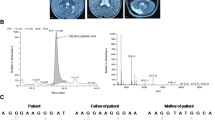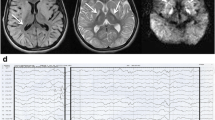Abstract
Objective
L-2-hydroxyglutaric aciduria is a genetic metabolic disorder. Its clinical features include elevated levels of hydroxyglutaric acid in body fluids and abnormal magnetic resonance imaging (MRI) in the subcortical white matter, which are affected by the accumulation of L-2-hydroxyglutaric acid.
Method
A boy with psychomotor retardation and progressive ataxia accompanied by abnormal brain MRI findings was tested using whole-exome sequencing.
Results
Next-generation sequencing (NGS) revealed two novel compound heterozygous frameshift mutations, c.407 del A (p.K136SfsTer3) and c.699_c700 ins A (p.D234RfsTer42), in the L-2-hydroxyglutarate dehydrogenase (L2HGDH) gene, leading to premature termination codons and truncated FAD/NAD(P)-binding domain of L2HGDH protein. Further laboratory testing revealed an increase in the 2-hydroxyglutaric acid level in the urine.
Conclusion
The results suggested that NGS could provide clues for identifying patients with abnormal neuroradiological findings in the subcortical white matter.




Similar content being viewed by others
References
Kranendijk M, Struys EA, Salomons GS, van der Knaap MS, Jakobs C (2012) Progress in understanding 2-hydroxyglutaric acidurias. J Inherit Metab Dis 35:571–587
Steenweg ME, Jakobs C, Errami A (2010) An overview of L-2-hydroxyglutarate dehydrogenase gene (L2HGDH) variants: a genotype-phenotype study. Hum Mutat 31:380–390
Vilarinho L, Tafulo S, Sibilio M, Kok F, Fontana F, Diogo L, Venâncio M, Ferreira M, Nogueira C, Valongo C, Parenti G, Amorim A, Azevedo L (2010) Identification of novel L2HGDH gene mutations and update of the pathological spectrum. J Hum Genet 55:55–58
Sue R, Nazneen A, Sherri B et al (2015) Standards and guidelines for the interpretation of sequence variants: a joint consensus recommendation of the american college of medical genetics and genomics and the association for molecular pathology. Genet in Med 17(5):405–424
Topçu M, Jobard F, Halliez S, Coskun T, Yalçinkayal C, Gerceker FO, Wanders RJA, Prud'homme JF, Lathrop M, Özguc M, Fischer J (2004) L-2-Hydroxyglutaric aciduria: identification of a mutant gene C14orf160, localized on chromosome 14q22.1. Hum Mol Genet 13(22):2803–2811
Van Schaftingen E, Rzem R, Veiga-da-Cunha M (2009) L: -2-Hydroxyglutaric aciduria, a disorder of metabolite repair. J Inherit Metab Dis 32:135–142
Rzem R, Veiga-da-Cunha M, Noël G et al (2004) A gene encoding a putative FAD-dependent L-2-hydroxyglutarate dehydrogenase is mutated in L-2-hydroxyglutaric aciduria. Proc Natl Acad Sci U S A 101:16849–16854
Steenweg ME, Jakobs C, Errami A, van Dooren SJM, Adeva Bartolomé MT, Aerssens P, Augoustides-Savvapoulou P, Baric I, Baumann M, Bonafé L, Chabrol B, Clarke JTR, Clayton P, Coker M, Cooper S, Falik-Zaccai T, Gorman M, Hahn A, Hasanoglu A, King MD, de Klerk HBC, Korman SH, Lee C, Meldgaard Lund A, Mejaški-Bošnjak V, Pascual-Castroviejo I, Raadhyaksha A, Rootwelt T, Roubertie A, Ruiz-Falco ML, Scalais E, Schimmel U, Seijo-Martinez M, Suri M, Sykut-Cegielska J, Trefz FK, Uziel G, Valayannopoulos V, Vianey-Saban C, Vlaho S, Vodopiutz J, Wajner M, Walter J, Walter-Derbort C, Yapici Z, Zafeiriou DI, Spreeuwenberg MD, Celli J, den Dunnen JT, van der Knaap MS, Salomons GS (2010) An overview of L-2-hydroxyglutarate dehydrogenase gene (L2HGDH) variants: a genotype-phenotype study. Hum Mutat 31:380–390
Aghili M, Zahedi F, Rafiee E (2009) Hydroxyglutaric aciduria and malignant brain tumor: a case report and literature review. J Neuro-Oncol 91:233–236
Vilarinho L, Cardoso ML, Gaspar P, Barbot C, Azevedo L, Diogo L, Santos M, Carrilho I, Fineza I, Kok F, Chorão R, Alegria P, Martins E, Teixeira J, Cabral Fernandes H, Verhoeven NM, Salomons GS, Santorelli FM, Cabral P, Amorim A, Jakobs C (2005) Novel L2HGDH mutations in 21 patients with L-2-hydroxyglutaric aciduria of Portuguese origin. Hum Mutat 26(4):395–396
Goffette SM, Duprez TP, Nassogne MC et al (2006) L-2-Hydroxyglutaric aciduria: clinical, genetic, and brain MRI characteristics in two adult sisters. Eur J Neurol 13:499–504
Jellouli NK, Hadj Salem I, Ellouz E et al (2014) Founder effect confirmation of c.241A>G mutation in the L2HGDH gene and characterization of oxidative stress parameters in six Tunisian families with L-2-hydroxyglutaric aciduria. J Hum Genet 59:216–222
Larnaout A, Amouri R, Kefi M et al (2008) L-2-hydroxyglutaric aciduria: clinical and molecular study in three Tunisian families. Identification of a new mutation and inter-familial phenotype variability. J Inherit Metab Dis 31(Suppl 2):S375–S379
O'Connor G, King M, Salomons G et al (2009) A novel mutation as a cause of L-2-hydroxyglutaric aciduria. J Neurol 256:672–673
Saifullina EV, Zakharova EY, Kurkina MV et al (2017) L-2-hydroxyglutaric aciduria caused by a new mutation in the L2HGDH gene. Zh Nevrol Psikhiatr Im S S Korsakova 117(4):81–85
Muhammad Ikram Ullah, Abdul Nasir, Arsalan Ahmad,et al (2018) Identification of novel L2HGDH mutation in a large consanguineous Pakistani family- a case report. BMC Med Genet 19:25
Jović NJ, Kosać A, Koprivšek K (2014) L-2-Hydroxyglutaric Aciduria: A Case Report. Srp Arh Celok Lek 142(5–6):337–341
Işıkay S, Ceylaner S, Karacan M (2014) A child with L-2 hydroxyglutaric aciduria presenting with dilated cardiomyopathy: coincidence or a new syndrome? Anadolu Kardiyol Derg 14:87–93
Faiyaz-Ul-Haque M, Al-Sayed MD, Faqeih E et al (2014) Clinical, neuroimaging, and genetic features of L-2-hydroxyglutaric aciduria in Arab kindreds. Ann Saudi Med 34(2):107–114
Najmabadi H, Hu H, Garshasbi M, Zemojtel T, Abedini SS, Chen W, Hosseini M, Behjati F, Haas S, Jamali P, Zecha A, Mohseni M, Püttmann L, Vahid LN, Jensen C, Moheb LA, Bienek M, Larti F, Mueller I, Weissmann R, Darvish H, Wrogemann K, Hadavi V, Lipkowitz B, Esmaeeli-Nieh S, Wieczorek D, Kariminejad R, Firouzabadi SG, Cohen M, Fattahi Z, Rost I, Mojahedi F, Hertzberg C, Dehghan A, Rajab A, Banavandi MJS, Hoffer J, Falah M, Musante L, Kalscheuer V, Ullmann R, Kuss AW, Tzschach A, Kahrizi K, Ropers HH (2011) Deep sequencing reveals 50 novel genes for recessive cognitive disorders. Nature 478(7367):57–63
Tai H (2015) Zhang Z. A novel compound heterozygous mutation in a Chinese boy with L-2-hydroxyglutaric aciduria: a case study. BMC Neurol 15(1):1–4
Mazzei R, Ungaro C, Garreffa G, Conforti FL, Mollo A, Sprovieri T, Servillo P, Blasi V, Gallo O, Cerasa A, Lanza PL, Quattrone A (2011) Genetic and magnetic resonance findings in an Italian patient affected by L-2-hydroxyglutaric aciduria. Neurol Sci 32:95–99
Moroni I, D'Incerti L, Farina L, Rimoldi M, Uziel G (2000) Clinical, biochemical and neuroradiological findings in L-2-hydroxyglutaric aciduria. Neurol Sci 21:103–108
Acknowledgments
The authors would like to thank Dr. Jia Jia and Zhang Dian of Shanghai Center for Bioinformation Technology for their help in data analysis.
Author information
Authors and Affiliations
Corresponding author
Ethics declarations
The study was performed in accordance with the ethical standards of the responsible committee on human studies (institutional and national) and also with the Helsinki Declaration of 1975 (revised in 2000). The ethical approved for the study was obtained from the Regional committee for Medical and Health Research Ethics, Children’s Hospital of Shanghai (Shanghai City, China) (REK 2017R021-F01). The patient’s parents provided informed consent.
Conflict of interest
The authors declare that they have no conflicts of interest.
Rights and permissions
About this article
Cite this article
Zhang, Y., Wang, C., Yang, K. et al. A novel compound heterozygous mutation of the L2HGDH gene in a Chinese boy with L-2-hydroxyglutaric aciduria: case report and literature review. Neurol Sci 39, 1697–1703 (2018). https://doi.org/10.1007/s10072-018-3483-2
Received:
Accepted:
Published:
Issue Date:
DOI: https://doi.org/10.1007/s10072-018-3483-2




